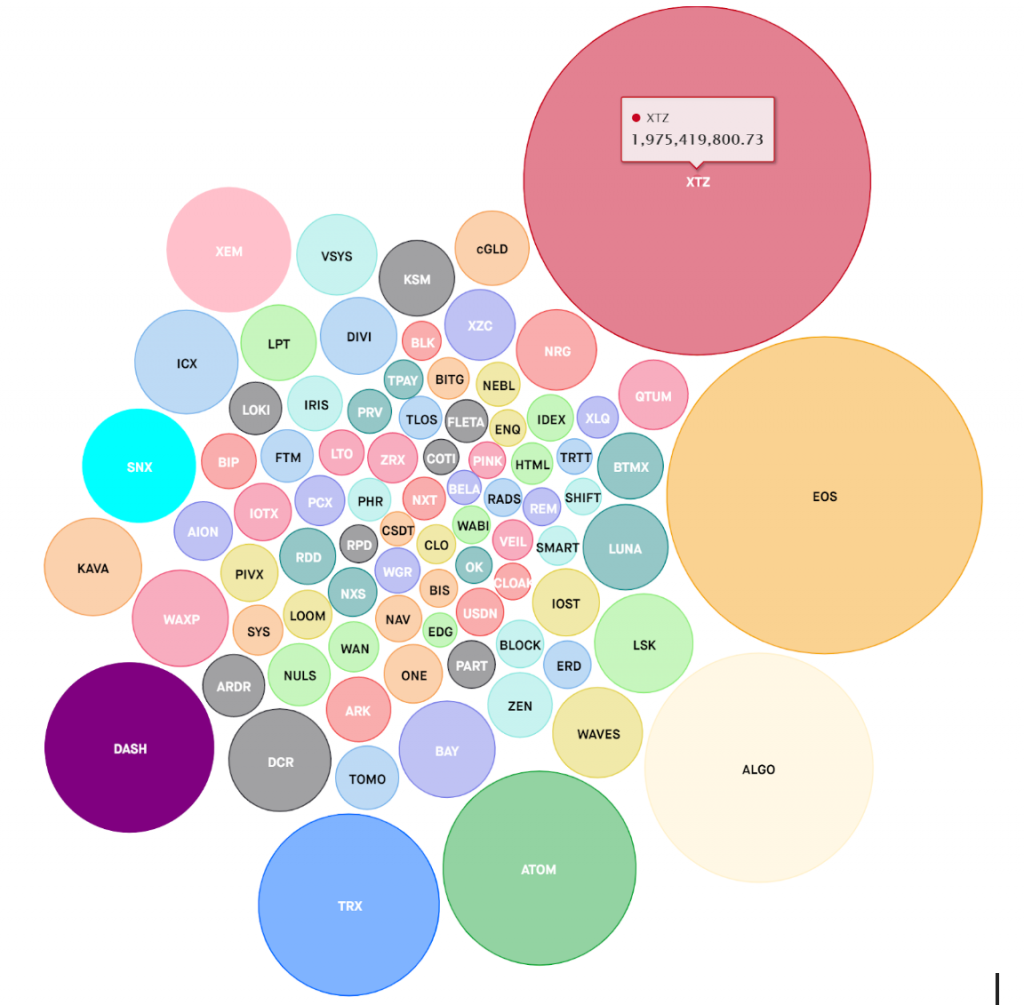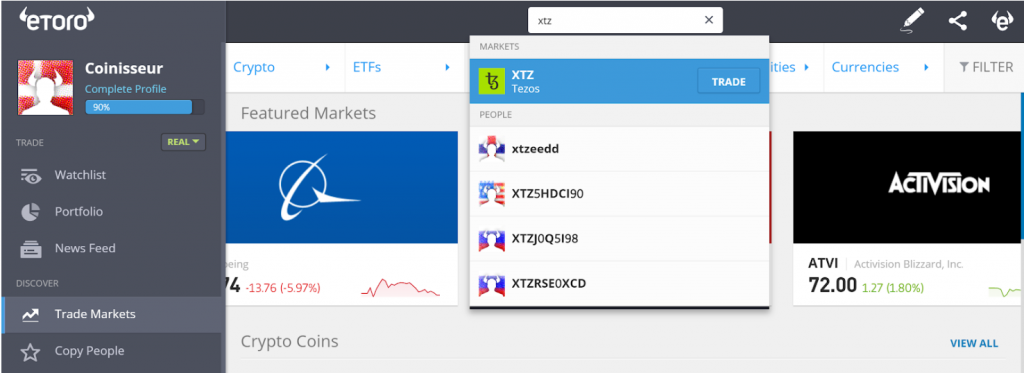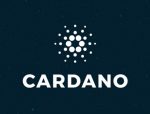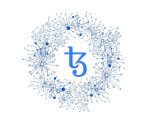Tezos (ticker XTZ) is in the top 20 cryptocurrencies according to Coinmarketcap.
 The features that set Tezos apart are on-chain governance, smart contracts and their formal verification (a method of mathematically proving program’s properties, e.g. a smart contract, which can aid in avoiding costly bugs and disputes), Dapps, and perhaps most importantly, a self-amending blockchain (which has been built from the ground-up). The latter fulfils the main goal of Tezos: to support new projects without having them undergo a fork, which often causes debates and fights within a given crypto community. Focus also falls on the safety and security of smart contracts, which are written in their own smart contract language.
The features that set Tezos apart are on-chain governance, smart contracts and their formal verification (a method of mathematically proving program’s properties, e.g. a smart contract, which can aid in avoiding costly bugs and disputes), Dapps, and perhaps most importantly, a self-amending blockchain (which has been built from the ground-up). The latter fulfils the main goal of Tezos: to support new projects without having them undergo a fork, which often causes debates and fights within a given crypto community. Focus also falls on the safety and security of smart contracts, which are written in their own smart contract language.
Tezos applies a kind of Proof-of-Stake consensus mechanism, dubbed Liquid Proof-of-Stake, or LPoS. Using this consensus mechanism uses less computing power compared to, for example, Bitcoin. Tezos is also interesting for less technical crypto enthusiasts, as you get tokens in exchange for holding the coin – so-called staking rewards.
The tokens are called tezzies and have a ticker XTZ.
| eToro is the world’s leading brokerage platform for social and copy trading. A 1000 different products are available on eToro, divided into 12 stock indices, 7 commodities, 53 ETFs, 49 currency pairs, including several cryptocurrencies (e.g. Bitcoin and Ethereum). Leverage of up to a 100 (leverage degree differs for some assets) is available. In our opinion, eToro is the best regulated exchange. You can join eToro here |
History of Tezos
Tezos has had a quite eventful history. Created in 2014, an ICO was held in summer 2017. It was one of the most successful ICOs at the time. But the serious infighting within the team that followed had delayed the launch of the mainnet, prompting some investors to consider prosecuting the company.
The people behind the project are Arthur and Kathleen Breitman and both have the ideal profile you want a crypto project to be run by. Kathleen worked for R3, a big blockchain consortium, and Arthur is a computer scientist and mathematician with experience of working in the financial sector for Morgan Stanley and Goldman Sachs.
The ICO finished on July 14, 2017, and was one of the most successful ones at the time. 65 703 bitcoins and 361 122 of ethereum were raised, equal to around $232 million at the time.
However, soon after the ICO, the trouble started. The issue revolved around clashes between the founders, Arthur and Kathleen Breitman, who controlled the underlying rights to the code, and the Foundation that ran the ICO, whose head, Johann Gevers, made it very difficult for the project to proceed. The Foundation was based in Switzerland, due to favourable laws. However, under that country’s law, the Foundation had the rights to all the assets raised from the ICO. And Gevers refused to give access to the assets. Not only the founders were locked out, but the investors also could not access or sell their tokens either. The matters became worse when a class-action complaint was filed against the heads of Tezos, including Gevers and Breitmans. The legal action stated that the ICO was a sale of unregistered securities, and included charges of securities fraud, false advertising, and unfair competition (it was finally resolved in March 2020). Meanwhile, over the span of 2017, the value of the assets doubled, quadrupled, and reached a total value of $1.2 billion when Bitcoin was worth $20,000 in December 2017. Gevers was fired, but it took weeks before he actually resigned. Over the course of the year, no progress was made on the blockchain. If you’re looking for more details, this WIRED article gives an extremely in-depth overview of the scandal.
After Gevers left, Tezos got a new board, a complete team was formed, and the work on the blockchain began in full. In an extremely short time, the team managed to create enough of their vision to launch the Betanet, which was launched at the end of June 2018. It was basically a fully functional network, with increased downtimes due to bug fixes and software updates. Most importantly, it allowed activation of the tezzies that were bought during the ICO, as well as trading the tokens.
The Mainnet launched in mid-September the same year, with all the trades and transactions from the Betanet present on the Mainnet – the Betanet basically turned into the Mainnet.
2019 – the year of (price) developments
XTZ started 2019 at $0.48. The price has been rising, reaching a high point of $1.83 on May 19th. The price fell and rose over the next few months (low point $0.85 on July 16 followed by a peak of $1.55 August 8). After a low point of $0.76 on October 23, the price rallied in the following weeks to reach $1.77 on December 12. Although the price has fallen for the rest of December and January, it has been rising lately, reaching $2.89 at the time of writing. In 2019, the price of Tezos rose more than 200%.
| At eToro you can trade 49 currency pairs, including several cryptocurrencies. Join eToro |
How does Tezos work?
Staking (‘baking’)
Staking is an easy way to make some money with cryptocurrencies by simply holding them. Some coins, including Tezos, NEO, and Dash regularly pay you a small amount of tokens based on the size of your holdings. The more coins you have, the higher payout you receive. When you hold coins, you can sign and publish blocks. This process is referred to as ‘baking’ on the Tezos network. Every year, the total supply of tezzies increases by 5%.
When you have a stake in Tezos, you get proportional block publishing rights. Once a block is baked, it needs to be notarized by 32 more bakers chosen at random. Then a block is added to the blockchain and the baker who added it receives a block reward and can charge transaction fees for the transfers in the block. Each token holder can give their baking rights to a delegate of their choice without losing the ownership of their coins. If a baker who added a block was delegated by other token holders, the reward is shared between all participants.
There are two kinds of accounts on the Tezos network, implicit and originated. Implicit accounts, most popular ones, can participate in the baking process, as long as they have been registered as a delegate. These are accounts that cannot bake, and instead have to choose a delegate – an implicit account holder.
If you have a finance background, staking might seem like normal interest on a savings account. And you wouldn’t be wrong. There are some differences though, mainly relating to taxation. Crypto and taxes is still a very chaotic area, with few countries having clear rules.
In the US, for example, staking might be understood as interest income, and the regulation in this area covers bank deposits, bond coupons, mortgage, and many more, it does not include cryptocurrencies. Instead, these would be legally defined as property (since cryptos are neither land nor a building, they are classed as personal property) and thus taxed differently.
Some would argue that staking discourages holders from actually spending their coins, decreasing the transaction volume and the level of usability of a given token. But despite this argument and the potential tax-related headaches, staking is often seen as an advantage of any cryptocurrency.
We will revisit staking later on and compare staking rewards of Tezos with other cryptocurrencies of this kind.
Liquid Proof-of-Stake
Contrary to Bitcoin, the tokens used on the Tezos network are not mined. Instead, it is the token holders that process and record transactions. This is the main difference between Proof-of-Work (PoW) used in Bitcoin, and Proof-of-Stake (PoS) used in Tezos. Additionally, while the ‘normal’ PoS would require the whole network, some kinds make use of delegates – elected users of the network that validate transactions, or as Tezos calls it, ‘bake’.
In Tezos, the consensus is called a Liquid Proof-of-Stake, and it bears some differences compared to other delegation based Proofs of Stake, such as that of EOS or TRON. The differences are shown in the table below.

On-chain governance and a self-amending blockchain
Token holders (both implicit and originated account holders) and developers can suggest changes or upgrades to the network. The community (holders of the coin) vote on the proposal, with the weight of their vote being proportional to the number of tezzies they hold. This means that the token holders have full control of the system.
Holders can choose to delegate their vote to someone they feel is more knowledgeable in the subject, for example, if there is a code update proposed, you might want to delegate your vote to a developer or a techie you trust. If the suggestion is approved, the developer receives tezzies. During the process, it is checked to make sure that no basic/vital parts of the blockchain have been changed. This encourages developers to work on what they want, rather than what the team wants them to do (also speaks to decentralisation).
Approved proposals are implemented with the self-amendment feature of Tezos, which is what sets it apart from other solutions on the market. Tezos can upgrade itself without the need to undergo a fork.
All of these aspects mean that the Tezos blockchain can evolve quicker than others and sustain its integrity over time.
| At eToro you can trade 49 currency pairs, including several cryptocurrencies. Join eToro |
Why is Tezos worth investing in?
Tezos has some advantages that make it a worthy investment consideration. The tech itself (self-amending blockchain and on-chain governance that eliminate hard forks, as well as being highly secure) is sound, XTZ also has a dedicated community, and the token itself seems to outperform many altcoins, especially since 2019. The staking rewards are also what draws many to this project. Moreover, the foundation is rumoured to have over $600 million, so they definitely have enough funds to support the business.
It is also important to mention the number and worth, more than $2.6 billion, of the STOs announced to take place on Tezos. Most notably, BTG Pactual – largest standalone investment bank in Brazil and tZERO – a blockchain solution provider that includes token issuance, management, and trading; subsidiary of Overstock.com.
Tezos compared
Tezos aims to improve on existing crypto-leaders, Bitcoin and Ethereum. Most of all, its goal was to minimise the internal disputes within a given crypto’s community due to hard forks. In Tezos, this is achieved with a combination of its distinctive governance and a self-amending blockchain. Between the two, XTZ is more similar to Ethereum, as just as Ethereum, it is a platform for smart contracts, but Tezos also facilitates smart contract verification and has (arguably) a better governance model. It has also been less power-consuming since it implemented a version of a Proof-of-Stake since the very start.
Besides Ethereum, Tezos can be compared against a number of projects, such as Tron and Cosmos.
Tron also uses a delegated Proof-of-Stake but is geared towards content creators. While in Tezos anybody can become a validator, in Tron there are 27 super representatives. You can delegate your vote, but only to one of those 27 validators. These validators are chosen every six hours, and whoever gets the most votes gets the position. Similarly to Tezos, the successful validator on Tron shares the block reward with their voters. Cosmos, a platform that aims to make it easy for developers to host dapps on their platform, also has a limited number of validators. In their case, it is 100. Looking further into the differences between the two, it seems that Cosmos is faster. However, Tezos is more decentralised, and it is much cheaper to become a validator. Which is one of the reasons why XTZ has far more validators than Cosmos. It should also be mentioned that while the tech between Cosmos and Tezos could be compared, they aim to do different things, with XTZ’s goal being a currency and a smart contracts protocol, and ATOM’s goal is to host and power decentralised applications.
In May 2019 a data analytics firm Omenics partnered up with Bitassist, a cryptoasset research firm, and carried out a competitive analysis of four leading protocols: Ethereum, EOS, Tron, and Tezos. Several aspects were compared: transactions per second (TPS), decentralisation and distribution (node count). The on-chain activity was also analysed, but at the time of the report Tezos mainnet had been too new and relevant data was not obtainable. You can find the report here (you will have to submit your email account).
When it comes to TPS, EOS has the largest capacity, even higher than fiat solutions like VISA. However, this is their potential and not the current reality. While Tezos might seem low, it has been noted that they are currently limited due to stability reasons, and could scale up the throughput without major changes to the code base.
When it comes to decentralisation (understood in the context of governance and the decision-making process in the system), Tezos comes second after Ethereum. In the context of decentralisation in terms of node distribution, Ethereum still leads in numbers. However, this is not surprising, given that it’s the only PoW blockchain among the ones being compared. When it comes to geographical distribution, Ethereum has the most nodes in more than 20 countries, followed by Tron in more than 15 countries, and EOS coming third. While Tezos is currently the least geographically distributed, it is mentioned that it launched its mainnet the latest of the four blockchains.
If you want to compare cryptos based on their adoption, technology, or overall rating, you might want to head to Weiss Crypto Ratings. This financial firm provides ratings for tokens across a variety of aspects. For example, when it comes to technology, several crypto platforms outperform Bitcoin and Ethereum, with Tezos taking the first place, overtaking Cardano which was rated the top technology token last month. Looking at the overall rating, with aspects such as tech/adoption and market performance, Tezos takes the 7th place, after Bitcoin, Ethereum, Cardano, IOTA, Ripple, and Litecoin.
According to Staking Rewards’, Tezos has the biggest staking network after overtaking EOS in April.

| eToro is the world’s leading brokerage platform for social and copy trading. A 1000 different products are available on eToro, divided into 12 stock indices, 7 commodities, 53 ETFs, 49 currency pairs, including several cryptocurrencies (e.g. Bitcoin and Ethereum). Leverage of up to a 100 (leverage degree differs for some assets) is available. In our opinion, eToro is the best regulated exchange. You can join eToro here |
How widely used is Tezos?
The scale of usability of a token, how many people regularly use it, is one of the most important features to consider when evaluating the future of it.
According to coingecko, at the time of writing XTZ has a market cap of over 2 billion USD, quickly catching up to EOS (2,4 billion USD). It is available on a relatively small number of exchanges – 53 compared to Ethereum’s 437 or 73 for Cosmos and a similarly low number of pairs, 95 (Ethereum has over 6000, Cosmos 144, and EOS and Tron both have between 400 and 500). This could be due to the fact that its mainnet is relatively young. So it could be argued that this number will only grow. Moreover, the major ones are present: Binance, eToro, Coinbase, Bitfinex, Kraken, OKEx, and Bittrex just to name a few.
When it comes to the community, XTZ is much larger than for example Cosmos, with many more average users online. It also has more posts per hour than Tron and Cosmos, and many more comments on the posts than EOS, Tron, and Cosmos (source).
It has a daily volume of 109 million USD, more than Cosmos (99 million USD), but much lower than Tron (1.3 billion USD), EOS (2.1 billion USD), and Ethereum (24.3 billion USD). And although a recent study has been found that only 18% of XTZ transactions lead to value transfer, this number is much larger than 5% for EOS (and only 2% for Ripple).
The adoption of the Tezos network is still growing. With the recent news that major companies (tZERO) and institutions (BTG Pactual) plan to launch their STOs on Tezos, it stands to reason that its usage will increase. And not only digitally. Recently, thanks to the crypto startup Digycode, France now has over 10,000 locations where you can purchase Tezos (along with a number of other cryptos) using prepaid coupons and gift cards.
Looking at the whole history of the token, it has fared much better than most. It survived the crypto winter of 2018. Achieving a higher price that much later after the ICO is something that the vast majority of the coins could not manage.
Where can I buy and trade Tezos?
Tezos is available on a number of exchanges (Binance, OKex, Huobi, Coinbase, eToro, Staking: Kraken and Binance) and wallets (Tezbox for staking, Ledger). A healthy level of liquidity. When it comes to wallets, you can store your XTZs in the TezBox (desktop and online), Tezos Blue (desktop and mobile), Tezor, and Ledger Nano S just to name a few.
Here is how to buy Tezos on etoro:
Search for Tezos ticker, XTZ, using the search bar at the top middle of the screen.

 You can either click on the result or on the trade button. Clicking on ‘TRADE’ will open the trading box, described next. If you click on the name, you will see XTZ’s page, which includes Feed, Stats, Chart, and Research (you need a funded account to access it), as seen below. You can also open the trade box by clicking ‘Trade’.
You can either click on the result or on the trade button. Clicking on ‘TRADE’ will open the trading box, described next. If you click on the name, you will see XTZ’s page, which includes Feed, Stats, Chart, and Research (you need a funded account to access it), as seen below. You can also open the trade box by clicking ‘Trade’.

After clicking the trade button, either straight from the search results or from the page, the following box will pop-up.

Choose the amount and click on ‘Open Trade’. You will get a confirmation at the bottom of the screen.

You can read our review of etoro here, and our guide on how to open an account here.
| eToro is the world’s leading brokerage platform for social and copy trading. A 1000 different products are available on eToro, divided into 12 stock indices, 7 commodities, 53 ETFs, 49 currency pairs, including several cryptocurrencies (e.g. Bitcoin and Ethereum). Leverage of up to a 100 (leverage degree differs for some assets) is available. In our opinion, eToro is the best regulated exchange. You can join eToro here |










